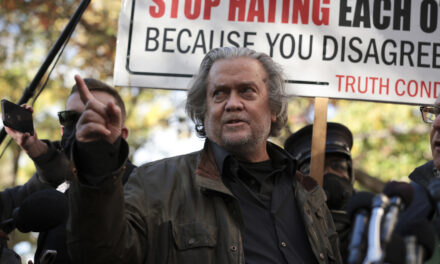
Live Trump vs Biden 2020 Election Updates
Video

transcript
transcript
Barrett Sworn In as Supreme Court Justice
The Senate voted 52 to 48 to confirm the nomination of Amy Coney Barrett, a conservative appeals court judge, eight days before the presidential election.
-
[music, “Hail to the Chief”] “In a few moments, we will proudly swear in the newest member of the United States Supreme Court, Justice Amy Coney Barrett. [applause] She is one of our nation’s most brilliant legal scholars, and she will make an outstanding justice on the highest court in our land.” “I will well and faithfully discharge …” “… the duties of the office on which I’m about to enter …” “… the duties of the office on which I am about to enter …” “… so help me God.” “… so help me God.” [applause] “The oath that I have solemnly taken tonight means at its core that I will do my job without any fear or favor, and that I will do so independently of both the political branches and of my own preferences.” “On this vote, the yeas are 52, the nays are 48. The nomination of Amy Coney Barrett of Indiana to be an associate justice of the Supreme Court of the United States is confirmed.” [applause] “Since the ink dried on the Constitution, only 114 men and women have been entrusted to uphold the separation of powers, protect people’s rights and dispense impartial justice on the Supreme Court. This is one of the most brilliant, admired and well-qualified nominees in our lifetime.” “I want to be clear with the American people: The Senate majority, this Republican Senate majority, is breaking faith with you, doing the exact opposite of what it promised four years ago, because they wish to cement a majority on the Supreme Court that threatens your fundamental rights. And I want to be very clear with my Republican colleagues: You may win this vote, and Amy Coney Barrett may become the next associate justice of the Supreme Court, but you will never, never get your credibility back.”

A divided Senate voted on Monday night to confirm Judge Amy Coney Barrett to the Supreme Court, capping a lightning-fast Senate approval that handed President Trump a victory days before the election and promised to tip the court to the right for years to come.
In a 52-to-48 vote, all but one Republican, Senator Susan Collins of Maine, who is battling for re-election, supported Judge Barrett, a 48-year-old appeals court judge and protégée of Justice Antonin Scalia.
Wasting no time, Mr. Trump held an unusual nighttime swearing-in ceremony for Judge Barrett on the South Lawn of the White House, a month to the day after a mostly maskless Rose Garden event attended by multiple people who later tested positive for the coronavirus, including Mr. Trump and the first lady. Though more precautions were taken at the ceremony on Monday, neither Mr. Trump nor Justice Barrett wore masks, perhaps because both already have had the virus and could be immune.
Justice Clarence Thomas, who swore in his new colleague, wore no mask, either, even though he is not known to have been previously infected. None of the other seven justices attended.
Mr. Trump praised Justice Barrett’s “deep knowledge, tremendous poise and towering intellect,” calling her a suitable replacement for Justice Ruth Bader Ginsburg, the liberal stalwart who died last month and was her ideological polar opposite.
In her remarks, Justice Barrett seemed intent on sending the message that she would not simply do Mr. Trump’s bidding, using the words “independent” or “independence” three times, even though he has said explicitly that he wanted her seated before the election so she could lend her vote in case of a legal dispute over the balloting.
“A judge declares independence not only from the Congress and the president, but also from the private beliefs that might otherwise move her,” Justice Barrett said after being sworn in. “The oath I have solemnly taken tonight,” she added, “means at its core that I will do my job without any fear or favor and that I will do so independently of both the political branches and of my own preferences.”
Neither Democrats nor Republicans seemed to believe that, instead commending or condemning her confirmation as a victory for conservatives and a defeat for liberals. Democrats immediately vowed on Monday night that there would be reprisals.
Representative Alexandria Ocasio-Cortez of New York called on Democrats to expand the court if they won the presidency and took control of the Senate, an idea that the Democratic presidential candidate, Joseph R. Biden Jr., has so far refused to co-sign. Mr. Biden instead has said that he would set up a bipartisan commission to look at ways to overhaul the court.
Senator Elizabeth Warren, Democrat of Massachusetts, excoriated her Republican colleagues in a fund-raising email to her supporters that was sent minutes after the vote.
“They stole another Supreme Court seat just eight days before the end of the election, after tens of millions of Americans had already cast their ballots, and just 15 days before the Supreme Court will hear a case that could overturn the Affordable Care Act,” Ms. Warren wrote.
In a statement late Monday, the Biden campaign called the Barrett confirmation “rushed and unprecedented,” and issued a call to action based on the Affordable Care Act case.
“If you want to say no, this abuse of power doesn’t represent you — then turn out and vote,” the statement said.
Justices can begin work as soon as they are sworn in, meaning Justice Barrett could be at work as early as Tuesday. The court is confronting a host of issues concerning the election and Mr. Trump’s policies, including cases from North Carolina and Pennsylvania about whether deadlines for receiving mailed ballots may be extended. Under the court’s usual practices, Justice Barrett cannot participate in cases that have already been argued, though they could be argued again before the full court if the justices are deadlocked.
Next Monday, the court returns to the virtual bench for a two-week sitting to hear arguments by telephone.

Welcome to the watch-what-they-do end of the presidential campaign. Don’t pay attention to what the candidates and their aides are saying about their how-to-win strategies in the final days. The best way to tell which states President Trump and Joseph R. Biden Jr. think are in play is to track their campaign travel.
Trips are being announced just a few days in advance, and the operative word is tentative. Candidates will make last-minute adjustments to their schedules based on the latest information from overnight polls (or prodding from worried supporters).
Case in point: Mr. Biden paid a quick trip to Pennsylvania on Monday. This is one of the most contested states on the map, which the president narrowly won last time and where polls now show Mr. Biden ahead. Mr. Trump has spent so much time in the state in recent days that it seems only a matter of time until Pennsylvania starts hitting him up for its resident income tax.
Mr. Biden heads to Georgia on Tuesday and to Iowa later in the week, two states Mr. Trump won in 2016 that are on the edge of the Democrats-have-a-chance map. It’s an aggressive move. Should Mr. Biden lose next Tuesday, expect the second-guessing brigade to inspect his decision to play offense when perhaps the game called for defense, and to invoke the trip Hillary Clinton made to Arizona at the end of the 2016 campaign.
But he is also going to Tampa, signaling how important Florida is, and how Democrats have put the president on the defensive in a state that he needs to win. (If early returns show Mr. Biden winning Florida next week, watch Democrats begin to pop the champagne.) And he is also heading to Wisconsin, as he tries to nail down the Big Three Midwestern states — the other two are Pennsylvania and Michigan — that lifted Mr. Trump over the 270 electoral vote hurdle four years ago.
Mr. Trump is spending a lot of time on defense this week, heading to states that he won in 2016 and where he is struggling today: Arizona and, of course, Michigan, Wisconsin and Pennsylvania. Assuming Mr. Trump can hold on to the rest of his 2016 map (and that may be a big assumption), he needs to hold just one of the three key Midwestern states to win re-election.
Interestingly, Mr. Trump is also going to Nevada, a state that Mrs. Clinton won in 2016. Nevada has not been extensively polled, and the surveys that have been done show a tight race there. Some clarity about the state of play in Nevada could come later Tuesday with the latest New York Times/Siena College Poll, which we are expecting to release around 1 p.m. Eastern.

In a decision that could reverberate beyond Wisconsin, the Supreme Court ruled on Monday night that Wisconsin could not accept ballots that arrive after polls close on Election Day, rejecting an appeal by Democratic-aligned groups.
The ruling comes as President Trump has continued to attack the election’s integrity and has singled out mail-in voting in particular. In a tweet late Monday, sent as the decision was still coming down, Mr. Trump falsely declared, without citing any evidence, that there were “Big problems and discrepancies with Mail In Ballots all over the USA. Must have final total on November 3rd.” (Twitter quickly put a warning label on the tweet.)
The Trump campaign and Republican allies are seeking similar restrictions on ballot deadlines in other states. In Pennsylvania, Republicans filed a new lawsuit last week, seeking to similarly mandate that all ballots arrive by Election Day, a decision on which the Supreme Court was locked in a 4-to-4 tie this month. Justice Amy Coney Barrett was confirmed on Monday night, giving conservatives a 6-to-3 majority.
In August, the Postal Service recommended that all voters make sure to mail their ballots no later than Oct. 27 to ensure that they arrive on time to be counted.
Lester Pines, whose law firm, Pines Bach, represented Gov. Tony Evers, a Democrat, in the Wisconsin case, said he hoped there would be enough time to alert voters who have not returned their ballots. “Don’t mail them now,” Mr. Pines said. “Find a way to get them delivered to the various places where they can be delivered.”
Mr. Pines said one part of Justice Brett M. Kavanaugh’s opinion was “very disturbing,” adding that it seemed to imply that the court might be again taking up the Pennsylvania ruling that it had let stand on the 4-4 vote.
According to the Wisconsin Elections Commission, 1,706,771 absentee ballots have been requested in Wisconsin, and 1,344,535 have been returned. More than 25 percent of those returned have come from two Democratic strongholds, Milwaukee and Dane County. Under state law, ballots must be received by Election Day.
Across the country, Democrats have been requesting absentee ballots at a greater rate than Republicans, and the trend is likely to hold in Wisconsin.
“As you know, more Republicans are going to vote in person, probably because of their preference to do so, and the president has been pushing that,” said Matt Batzel, the Wisconsin-based national executive director for American Majority Action, a conservative grass-roots political training organization. “Democrats have really staked their strategy on pushing absentee ballot requests and following up with those individuals. This ruling is deflating to that strategy.”
The Democratic Party of Wisconsin immediately announced on Twitter a voter education project to alert constituents that absentee ballots must be received by 8 p.m. on Nov. 3 — and began fund-raising around the ruling. “We’re dialing up a huge voter education campaign,” tweeted Ben Wikler, the state party chairman.
The spring elections in Wisconsin were disrupted by a similar set of lawsuits seeking ballot deadline extensions to help alleviate delays in the Postal Service amid the pandemic, as the Supreme Court eventually allowed for a six-day extension provided that ballots had been postmarked by the election.
The Wisconsin Elections Commission estimated that roughly 79,000 additional ballots were counted in April as a result of that decision.
In 2016, Mr. Trump carried Wisconsin by about 23,000 votes.

President Trump will hold his election night party at his hotel in Washington, a senior Republican official with knowledge of the plans confirmed Monday night, setting up a potential standoff with the city’s Democratic mayor over the district’s limits on gatherings.
The White House has largely ignored those limits during the coronavirus pandemic, most notably in August when Mr. Trump hosted more than a thousand supporters on the White House lawn for the speech in which he accepted the Republican nomination for president.
At another event on Sept. 26, Mr. Trump introduced his Supreme Court nominee, Justice Amy Coney Barrett, in front of a crowd of several hundred people in the Rose Garden. The president and the first lady are among at least 11 people who have tested positive since attending the ceremony, which the health authorities later called a “super-spreader event.”
The District of Columbia has little say over events on the White House grounds, but the campaign’s selection of the Trump International Hotel as the venue for the president’s election night festivities could be different.
Gatherings are capped at 50 people in Washington under the city’s emergency orders. At a news conference on Monday outlining the city’s plans for dealing with a second wave of virus cases, the city’s mayor, Muriel Bowser, said she had become aware of the plans for the election night gathering, and suggested that the city could take action against the hotel.
“I heard about something this morning,” Ms. Bowser said. “We will be in touch with our licensee, which is the hotel.”
A Trump campaign spokesman and the hotel did not respond to requests for comment on Monday night.
The president and the mayor have clashed on a number of fronts this year, from the White House’s lack of cooperation with contact tracing efforts after the earlier outbreak of the virus in the West Wing to the federal government’s use of National Guard units in June to disperse protests that followed the police killing of George Floyd.
The Trump hotel, a destination for lobbyists, foreign politicians, religious groups and Fox News personalities, has been the source of multiple disputes during Mr. Trump’s first term, including complaints that the president was blurring the lines between his businesses and his office. It is a few blocks from the White House in a federally owned building on Pennsylvania Avenue. The Trump organization signed a 60-year lease to operate it in 2013.

















